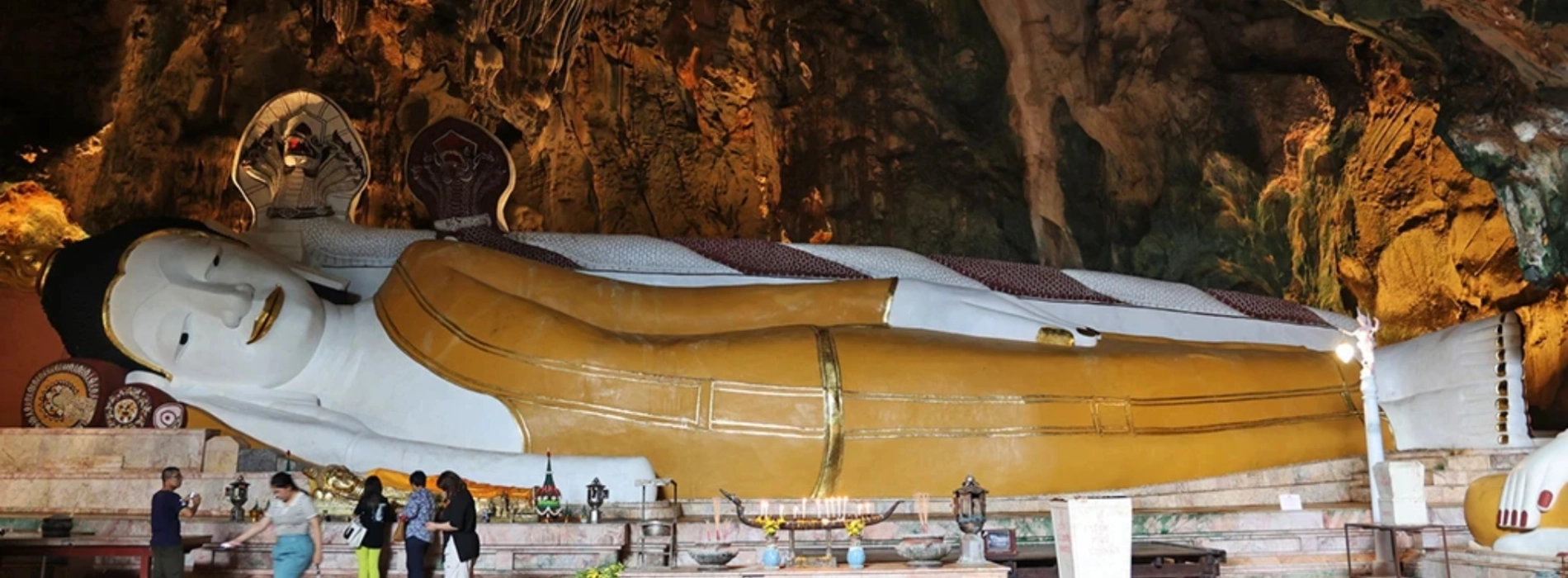Wat Khuha Phimuk

Wat Khuha Phimuk, also known as Wat Na Tham, is a temple with an extraordinary blend of ancient Buddhist architecture and natural cave formations, especially its location when it is nestled in Mueang Yala, Yala district. This lush land has attracted visitors who look for a serene and spiritual region and are drawn to its majestic spiritual ambiance.
Wat Na Tham, in the eyes of visitors, is a hidden gem that offers a significant journey into Buddhists’s religious and cultural heritage due to its charming caves, sacred relics, and intricate carvings. Be ready to dive into what makes this one of Yala’s most unique and awe-inspiring destinations.
Wat Khuha Phimuk is an important sacred place of the South, just like Phra Borommathat, Nakhon Si Thammarat Province, and Phra Borommathat Chaiya, Surat Thani Province. It represents the prosperity of Buddhism in this area since the Srivijaya Empire.
.jpg)
History of Wat Khuha Phimuk. (Source: Petit Fute)
The area of the temple is shady, with a stream flowing through it. The stairs lead up to the mouth of the cave that contains a giant statue, which the local people call “Chao Khao." It was built by local artisans in 1941. The interior of the cave looks like a large hall that has been converted into a religious place.
There is a chimney at the ceiling of the cave, and when the sun shines down, it looks very beautiful. The Buddha image is assumed to have been built in the Srivijaya period around 757.
It is believed that it was originally the statue of Narai Bantomsin because there is an image of a Naga over the Buddha’s head. Later, it was converted into a reclining Buddha in the Hinayana style.
.jpg)
Highlights of Wat Khuha Phimuk. (Source: Asia King Travel)
While entering the sacred land, you will have a chance to witness a shrine with a huge Buddha statue surrounded by lesser relics and offerings. This is the main cave of Wat Khuha Phimuk, Tham Na Tham, or the site’s focal point. This special point is a blend of man-made structures and natural rock formations, which offers a tranquil environment for visitors coming here. Furthermore, the naturally filtered light enhances the serene ambiance for peaceful meditation or reflection.
All the stupas and statues of this temple are totally significant emblems, which honor the Buddha and figures in Thai Buddhism throughout the temple’s surroundings. Being embellished with traditional Thai ornamentation, each stupa is both in the open air or inside the cave, symbolizing different elements of Buddhist philosophy. In addition, you may see all the ancient relics related to Thai spirituality, which will be an unforgettable experience of your journey.
The walls of Wat Khuha Phumik, adorned with scenes describing Buddhist mythology and historical events based on Jakata tales from previous generations and other religious narratives, cover the entire interior. Those crafted by local artisans are more than just art; they are good lessons, which symbolically inspire spirit-worshipping communities about life, compassion, and the pursuit of enlightenment.

Highlights of Wat Khuha Phimuk. (Source: transviet.com.vn)
One special thing about this temple is the natural meditation area, which includes completely quiet chambers for monks and visitors to practice mindfulness. As a unique mixture of quiet atmosphere, cool air, and soft echoes, this temple has created a conductive space for deep reflection and tranquility for those desiring to experience the essence of Buddhist meditation in a serene, undisturbed setting.
Into the cave, you may witness stunning stalactite and stalagmite structures, which contribute to the ambiance, creating an almost magical environment. According to Buddhist philosophy, these structures symbolically represent patience and endurance with which natural processes occurred over millennia.
You may have a great view from the temple to see the lush woods and distant hills as a feeling of detachment from the bustling world, which allows people a space for introspection and connection with nature when Wat Khuha Phumik offers splendid views of the surrounding Yala province.
Wat Khuhaphimuk is best visited between November and February, when Thailand's temperatures are lower. It is simpler to explore the cave and the surrounding area during these months because of the warmer temperatures. Consider going during a Buddhist holiday, when the temple is full of celebratory spirit.

Best time to visit Wat Khuha Phumik. (Source: transviet.com.vn)
If you travel from Yala city center, you can easily access local transport because this temple is located just outside Yala city. Or if you’re a thriller sicker, you can try taxi rentals that are available, and they will take around 15-30 minutes.
Yala is easily accessible by train and bus from adjacent regions. Private automobiles are also available, with adequate signage going to the shrine. Visitors arriving from Songkhla or Hat Yai can reach the shrine in a few hours.
Wat Khuhaphimuk, also known as Wat Na Tham, combines history, spirituality, and natural beauty in a perfect way. This tranquil temple combines natural cave structures with complex Buddhist architecture to provide a unique view into Thailand's spiritual traditions. Whether you're a spiritual seeker, a history buff, or a visitor looking for a peaceful respite, Wat Khuhaphimuk guarantees a unique experience. So enter the calm atmosphere of Wat Na Tham and uncover a piece of Thailand's cultural heart in Yala.
Read more: Thai Cuisine vs Vietnamese Cuisine: What’s the Difference?